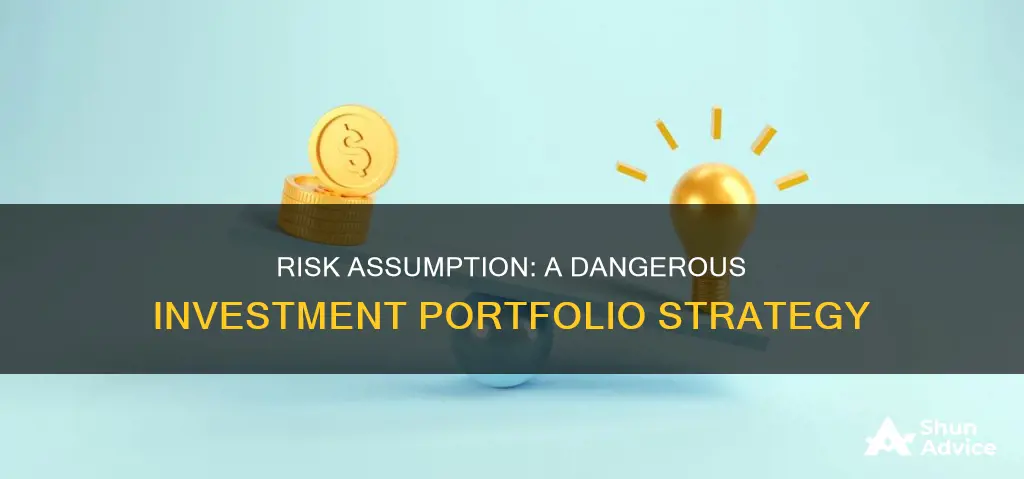
When it comes to investing, it's important to understand the risks involved and not make assumptions. All investments carry some level of risk, and it's crucial to assess your risk tolerance and capacity before making any decisions. The relationship between risk and return is crucial: higher-risk investments offer the potential for greater returns but also come with a higher possibility of loss. It's important to carefully evaluate your financial goals, time horizon, income, savings, and other factors to determine the appropriate level of risk for your investment portfolio. Diversification and asset allocation are essential strategies to manage risk and protect against significant losses.
| Characteristics | Values |
|---|---|
| Risk | Uncertainty with respect to your investments that has the potential to negatively impact your financial welfare |
| Reward | The possibility of higher returns |
| Risk Capacity | Your objective ability to take on financial risk |
| Risk Tolerance | Your willingness to take on risk and deal with uncertainty |
| Liquidity Risk | How easy or hard it is to cash out of an investment when you need to |
| Concentration Risk | The number of investments you hold |
What You'll Learn

Understand the relationship between risk and return
Understanding the relationship between risk and return is crucial for investors to make informed decisions and strike the right balance between potential gains and potential losses. In the world of finance, the relationship between risk and return is a fundamental concept that guides investment decisions. Put simply, the potential for higher returns often comes with a higher level of risk.
Risk refers to the uncertainty and variability associated with an investment, while return represents the gain or loss generated from that investment. Different investments carry different levels of risk. For example, stocks have a higher level of volatility and therefore carry a higher level of risk, whereas investments like government bonds are considered less risky as they offer a more stable and predictable return.
The level of risk an investor is willing to accept depends on various factors, including their investment goals, time horizon, and risk tolerance. Risk tolerance refers to an individual's ability to handle fluctuations in the value of their investments and their willingness to take on risk. Some investors have a high-risk tolerance and are comfortable with the potential for higher returns, even if it means experiencing significant fluctuations in the value of their investments. Others have a low-risk tolerance and prefer more stable investments, even if it means accepting lower returns.
The relationship between risk and return is often depicted by the risk-return tradeoff, which states that investors must be compensated for taking on additional risk. In other words, the potential for higher returns comes with a higher level of risk. This relationship holds true across different asset classes and investment options. For example, stocks have historically offered higher returns compared to bonds but also come with higher volatility and risk.
Understanding the relationship between risk and return is key to making informed investment decisions and achieving financial goals. It helps investors set realistic expectations, manage their portfolios effectively, and navigate the complexities of the financial markets with greater confidence. While the allure of high returns can be tempting, it's important to carefully consider the associated risks and how they align with one's financial goals and risk tolerance.
To effectively manage risk and maximize the potential for returns, investors can employ strategies such as diversification, setting clear investment goals, conducting thorough research and analysis, and utilizing risk management tools. Diversification involves spreading investments across different asset classes, sectors, and geographic regions to reduce the impact of individual investment losses on the overall portfolio. By combining diversification with other risk management strategies, investors can make more informed decisions and increase their chances of achieving their financial objectives while minimizing potential setbacks.
Private Equity Investing: A Comprehensive Guide
You may want to see also

Evaluate your comfort zone for taking on risk
Evaluating your comfort zone for taking on risk is a crucial aspect of successful long-term investing. All investments carry some degree of risk, and it's important to understand that you could lose some or all of your money. Before investing, it's essential to assess your risk tolerance and determine how much risk you are comfortable taking on. Here are some factors to consider when evaluating your comfort zone for taking on risk:
- Risk Tolerance: Risk tolerance refers to an individual's psychological willingness to take risks to achieve better financial returns. It's essential to understand your risk tolerance and ensure that your investments align with it. Are you comfortable with high-risk investments, or do you prefer a more conservative approach? Be honest with yourself about your ability to handle potential losses.
- Financial Goals: Consider your financial goals and the time horizon for those goals. If you have long-term financial goals, such as retirement planning or saving for college, you may need to include higher-risk investments, like stocks or mutual funds, in your portfolio to achieve the desired returns. On the other hand, if you have shorter-term goals, lower-risk investments like cash equivalents may be more appropriate.
- Diversification: Diversifying your investments across different asset classes, such as stocks, bonds, and cash, can help manage risk. By spreading your investments, you reduce the impact of any single investment loss. Diversification ensures that your portfolio is not overly exposed to any specific risk and provides a smoother investment journey.
- Risk-Return Trade-off: Understand the risk-return trade-off. Higher-risk investments typically offer the potential for higher returns, while lower-risk investments may provide more stable but lower returns. Evaluate your comfort with the level of risk you are taking on and whether the potential returns justify that risk.
- Risk Assessment Tools: Utilize risk assessment tools and questionnaires to help gauge your risk comfort more accurately. These tools can provide a more detailed analysis of your risk tolerance and help you make more informed investment decisions.
- Seek Professional Advice: Consult a financial professional or advisor to discuss your risk comfort and investment options. They can provide personalized advice and help you construct a portfolio that aligns with your risk tolerance and financial goals.
Remember, evaluating your comfort zone for taking on risk is a highly personal process. It's essential to be honest with yourself and seek a level of risk that aligns with your financial goals and tolerance for potential losses. By taking the time to assess your comfort zone, you can make more informed investment decisions and improve your chances of achieving your financial objectives.
Private Investment: When Planning Exceeds Saving
You may want to see also

Diversify your investments
Diversifying your investments is a crucial aspect of managing your investment portfolio and mitigating risk. Here are some detailed instructions and considerations to help you diversify your investments effectively:
Understand the Concept of Diversification
Diversification is based on the idea of "not putting all your eggs in one basket." By spreading your investments across various assets, you reduce the potential loss if one investment underperforms. Diversification does not guarantee gains or eliminate losses but improves your chances of maintaining or growing your wealth over time.
Determine Your Risk Tolerance and Time Horizon
Before diversifying, evaluate your comfort with taking on risk and your investment goals. Younger investors may opt for a more aggressive approach, balancing potential growth with the risk of inflation. As you near retirement, you may shift towards more conservative investments to protect your savings. Your time horizon is crucial – a longer time horizon may allow for a higher-risk, higher-reward strategy, while a shorter horizon may call for a more stable approach.
Allocate Your Assets
Allocate your investments across different asset classes, such as stocks, bonds, cash, and alternative investments. Stocks typically represent the most aggressive portion of a portfolio, with higher growth potential but greater volatility. Bonds are generally less volatile and provide regular income. Cash investments, like money market funds, offer stability and liquidity but may not keep up with inflation over time.
Diversify Within Asset Classes
When investing in stocks, consider a mix of domestic and international options. Include a variety of sectors to avoid over-specialization. For bonds, explore US Treasury bonds, high-quality corporate bonds, and consider some higher-yield options. For alternative investments, explore real estate investment trusts (REITs), commodity-focused funds, and sector funds.
Monitor and Adjust Your Portfolio
Stay informed about market conditions and the performance of your investments. Be prepared to make changes when necessary. As your risk tolerance and time horizon change, adjust your portfolio accordingly. For example, as retirement nears, shift towards more conservative investments to protect your savings.
Avoid Over-Diversification
While diversification is essential, be cautious not to over-diversify. Adding too many investments can dilute your returns and increase complexity. A manageable number of diverse investments, around 20-30, is generally recommended. Ensure that each addition to your portfolio aligns with your goals and risk tolerance and does not increase overall risk without a corresponding potential for higher returns.
In conclusion, diversifying your investments is a powerful strategy to manage risk and pursue your financial goals. By allocating your assets across various investments and staying vigilant, you can improve your chances of long-term success and reduce the potential impact of market downturns.
Savings and Investment: Finding Equilibrium Balance
You may want to see also

Understand your risk capacity and tolerance
Understanding your risk capacity and tolerance is crucial when it comes to investing. Risk capacity refers to your financial ability to endure potential losses, while risk tolerance is about your psychological willingness to take on risk.
Risk capacity is determined by concrete financial circumstances like income, debt, savings rates, withdrawal requirements, job and income security, and time horizon. For example, an investor with a stable income, limited debt, and a long time horizon may have a higher risk capacity.
Risk tolerance, on the other hand, involves how individuals respond emotionally or behaviourally towards risk. It is influenced by a person's life experiences, upbringing, knowledge level, current mood, and various other factors.
To effectively manage your investment portfolio, it is important to assess both your risk capacity and tolerance. Here are some steps to help you understand and align these aspects:
- Self-Assessment and Professional Guidance: Undertake a thorough self-reflection to understand your risk tolerance, and consider consulting financial advisors for tailored advice.
- Balanced Portfolio Construction: Create a portfolio that respects your emotional comfort and financial reality. This may involve diversifying your investments across various asset classes, such as stocks, bonds, mutual funds, exchange-traded funds, property funds, and cash.
- Regular Review and Adjustment: Regularly review and adjust your financial plan and investment strategy as your financial landscape and personal circumstances evolve.
- Education: Enhance your financial literacy and understanding of investment principles to make more informed decisions and potentially increase your comfort with calculated risks.
By following these steps, you can strive to achieve harmony between your risk capacity and tolerance, leading to a more coherent and less stressful investment experience.
Acorns Investment: Choosing the Right Portfolio for You
You may want to see also

Consider your financial goals
When considering your financial goals, it's important to be realistic and honest with yourself. Ask yourself what you want to achieve with your investments. Are you investing for your retirement, your child's education, or perhaps a large purchase like a home or business? Each of these goals will have different time horizons, and it's crucial to understand the timeline within which you want to achieve them.
Your financial goals will also depend on your current financial situation. Are you investing with disposable income, or is this money you need for essential expenses such as housing, food, or education? Be sure to consider both your short- and long-term spending requirements, as well as your overall financial needs and net worth.
Understanding your risk tolerance is key to achieving your financial goals. If you are inherently cautious, you may want to avoid high-risk investments, even if you can technically afford to take on more risk. On the other hand, if you are comfortable with market volatility and have a long time horizon, you may be suited to a more aggressive portfolio.
It's also important to remember that higher-risk investments can lead to higher returns. If your financial goal is a long way off, you may be able to take on more risk, knowing that you have time to recover from any market downturns. However, if your goal is approaching, you may want to shift to more conservative investments to protect your capital.
Finally, consider the level of diversification in your portfolio. Diversification can help manage risk and create a solid foundation for your investments. By investing in a variety of asset classes, such as stocks, bonds, and cash, you can reduce the impact of market volatility and improve your chances of meeting your financial goals.
National Savings and Investments: A Secure Financial Future
You may want to see also
Frequently asked questions
With higher risk comes a higher possible return, but also a higher possible loss. If you invest in lower-risk products, there is a decreased chance of suffering a loss but the investment returns will be lower.
Your individual risk profile is specific to you and has two parts: risk tolerance and risk capacity. Risk tolerance captures your willingness to take on risk and deal with uncertainty. Risk capacity is your objective ability to take on financial risk, or how much of your investments you can lose without it negatively affecting you and your life.
Your financial advisor should ask you several questions to understand both your risk tolerance and risk capacity. You can also fill out an investor questionnaire.
Two basic investment strategies—asset allocation and diversification—can help manage both systemic risk and non-systemic risk. Hedging and insurance products can also help manage risk, but they typically add to the costs of your investment.
You cannot eliminate investment risk entirely. However, you can better understand the nature of risk and take steps to manage those risks, putting yourself in a better position to meet your financial goals.







